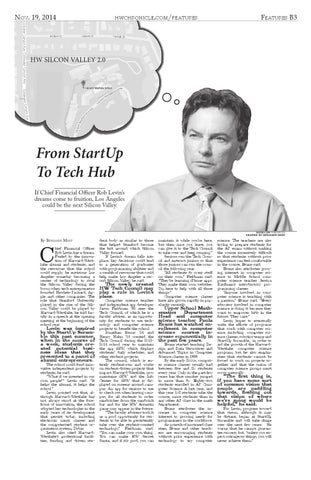Nov. 19, 2014
hwchronicle.com/features
Features B3
HW SILCON VALLEY 2.0
From StartUp To Tech Hub If Chief Financial Officer Rob Levin’s dreams come to fruition, Los Angeles could be the next Silicon Valley.
SACHA LIN/CHRONICLE GRAPHIC BY BENJAMIN MOST
By Benjamin Most
C
hief Financial Officer Rob Levin has a dream. Fueled by the innovation of Harvard-Westlake alumni and students, and the resources that the school could supply, he envisions Los Angeles someday becoming a center of technology to rival the Silicon Valley during the boom when tech entrepreneurs founded Hewlett-Packard, Apple and other companies. The role that Stanford University played in the rise of the Silicon Valley could be played by Harvard-Westlake, he told faculty in a speech at the opening meeting at the beginning of the school year.
Levin was inspired by the StartUp Scramble this past summer, when in the course of a week, students created potential business ideas that they presented to a panel of alumni entrepreneurs.
The school could fund innovative independent projects by students, he said. “What if we invested in our own people?” Levin said. “It helps the alumni, it helps the school.” Levin pointed out that, although Harvard-Westlake has not always stood at the forefront of innovation, the school adopted key technologies in the early years of its development that persist today, including electronic music classes and the computerized student organization system, Didax. Levin also cited HarvardWestlake’s professional facilities, funding and driven stu-
dent body as similar to those that helped Stanford become the hub around which Silicon Valley formed. If Levin’s dream falls into place, key decisions could lead to a generation of graduates with programming abilities and a wealth of resources that could help make Los Angeles a second Silicon Valley, he said.
The newly created HW Tech Council may play a role in Levin’s plans.
Computer science teacher and independent app developer Jason Fieldman ’98 sees the Tech Council, of which he is a faculty adviser, as an opportunity for students to use technology and computer science projects to benefit the school. Jonathan Burns ’14 and Henry Hahn ’14 created the Tech Council during the 20132014 school year to maintain the app iHW, which displays students’ daily schedules, and other student projects. The council, which is entirely student-run and works on student-driven projects that impact Harvard-Westlake, now maintains iHW and the Info Center for iHW that is displayed on screens around campus. An app for seniors to use to check out when leaving campus, for all students to order sandwiches from the sandwich bar and for the HW Assassin game may appear in the future. “The faculty advisers took it as a good opportunity for students to be able to persistently take over the student-created technology,” Fieldman said. “You can make your own thing. You can make HW Secret Santa, and if it’s good, you can
maintain it while you’re here, but then once you leave, you can give it to the Tech Council to take over and keep running.” Seniors run the Tech Council and instruct juniors so that those juniors can run the council the following year. “All students do crazy stuff on their own,” Fieldman said. “They’re learning iPhone apps. They make their own websites. I’m here to help with all those things.” Computer science classes have also grown rapidly in popularity recently.
Upper School Mathematics Department Head and computer science teacher Paula Evans has watched enrollment in computer science courses increase exponentially in the past few years.
Evans started teaching Design and Data Structures and Advanced Topics in Computer Science classes in 1999. By the early 2000s, computer science classes usually had between five and 20 students every year. Only in the past few years has that number jumped to more than 50. Eighty-two students enrolled in AP Computer Science A last year, and this year 102 students take the course, more students than in any other AP class in the math department. Evans attributes the increase in computer science interest to growing needs for programmers in the workforce. As a result of increased class sizes, Evans and other teachers are encouraging students without prior experience with technology to try computer
science. The teachers are also trying to prepare students for the AP exam without making the course excessively difficult so that students without prior experience can feel comfortable in the course, Evans said. Evans also attributes growing interest in computer science to Middle School computer science teacher Jessica Kaufman’s introductory programming classes. “Anyone involved in computer science is teaching with a passion,” Evans said. “Every educator involved in computer science is doing it because they want to empower kids in the future. They care.” Levin hopes to eventually unite the efforts of programs that work with computer science, including computer science classes, robotics teams and StartUp Scramble, in order to aid the growth of the HarvardWestlake computer science program, but he also emphasizes that students cannot be forced to work on projects together and that the union of computer science groups must occur naturally.
“The first thing is, if you have some sort of common vision that people are paddling towards, fleshing out that vision of where we’re going would be helpful,” he said.
For Levin, progress toward that vision, although it may be distant, began at StartUp Scramble and will take shape over the next few years. He warns that he cannot guarantee success, but, “unless you expect outrageous things, you will never achieve them.”
